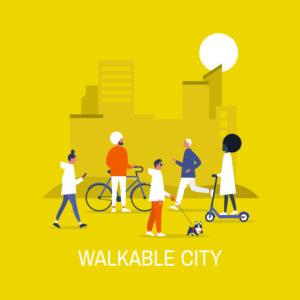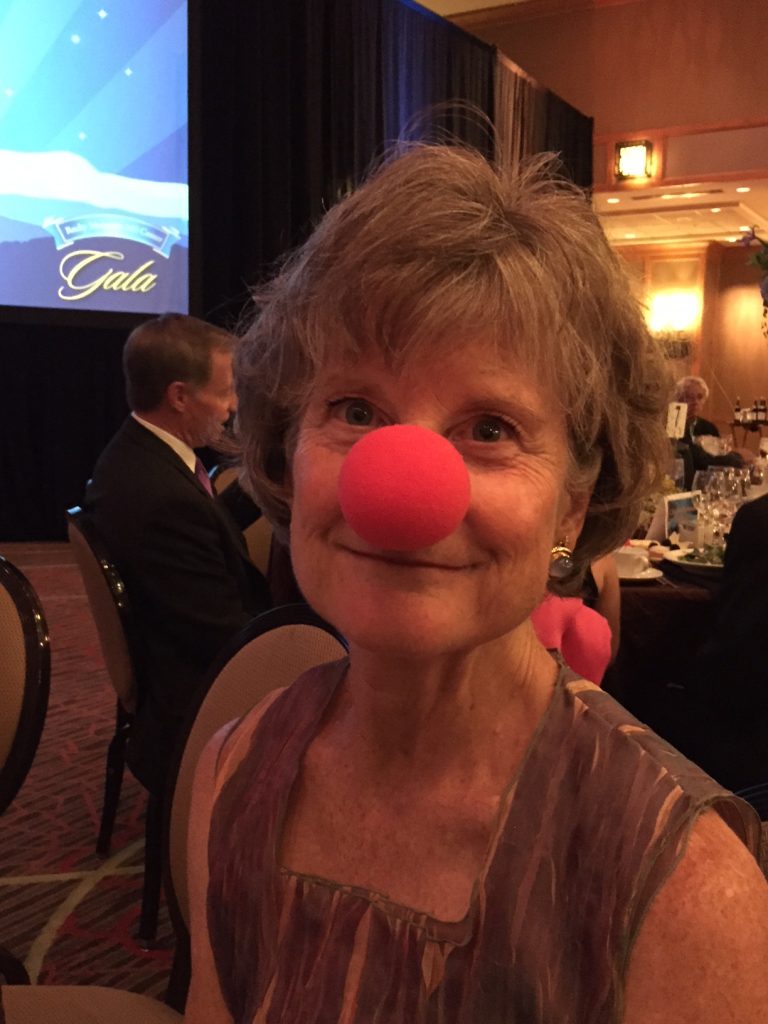Walking Up The Economic Ladder
 Want your kids to have a better life than you do? Move to a more walkable neighborhood.
Want your kids to have a better life than you do? Move to a more walkable neighborhood.
That’s the upshot of a study recently published in American Psychologist. The authors, Shigehiro Oishi, Minkyung Koo, and Nicholas Buttrick, correlated neighborhood walkability with intergenerational upward social mobility. The basic finding: kids who grow up in walkable neighborhoods are more likely to move upward – as compared to their parents – than kids who don’t live in walkable neighborhoods.
The authors begin by noting that “Although upward mobility is generally in decline in the United States …it is easier to get ahead in some parts of the United Sates than in others.” Kids growing up in Pittsburgh, for instance, are much more likely to rise from the bottom 20% (as kids) to the top 20% (as adults) than are kids growing up in Charlotte, North Carolina.
Why would that be? Previous research had identified five factors associated with socioeconomic fluidity for a given area. These are “1) less residential segregation, 2) less income inequality, 3) better primary schools, 4) greater social capital, and 5) greater family stability.” (Social capital is a measure of community participation, including the proportion of people in a given area who vote, volunteer, and otherwise engage in community activities).
Oishi, Koo, and Buttrick accept the “Five Factors” and ask an additional question: does the walkability of a neighborhood also contribute to social fluidity? The authors conducted four different studies to answer this question. Here are some of the top-level findings.
- Comparing 389 commuting zones with walkability ratings from walkscore.com, “showed that upward social mobility was substantially higher in more walkable commuting zones than in less walkable commuting zones.” (r = .390, p<.001)
- But, wait. Maybe it was the Five Factors as opposed to walkability per se. The researchers held the Five Factors constant and found that “walkability explained 11% of additional variance uniquely” beyond the Five Factors. (R2 rose from .41 to .52).
- But, wait. Maybe walkable areas are also more liberal politically – and the liberal policies promote social fluidity as opposed to walkability. Or maybe it’s because walkable areas are healthier and healthier people are more socially fluid. Nope. The researchers held these variables constant (as well as several others). “Overall, walkability was a robust predictor of upward social mobility beyond factors previously used….”
- Why, then would walkability promote social fluidity? One finding is that people have less need for cars in walkable neighborhoods. People without cars can compete effectively for jobs in a wider geographic area.
- Additionally, walkability seems to promote a “sense of belonging” in a neighborhood. The researchers found that these feelings of belonging were “themselves associated with upward social mobility”.
- Does it only work in America? Does this reflect the individualism of America or is it also present in more collectivist societies? The researchers collected data from South Korea, which they describe as a “vertical, collectivist culture”. The finding: “… frequency of walking was indeed associated with a greater sense of belonging, which was in turn associated with upward social mobility.”
This study raises bigger, broader questions as well. Numerous commentators have noted that upward mobility in the United States has declined precipitously over the past 50 to 75 years. Baby boomers may be the last generation to do broadly better than their parents.
This time frame corresponds to the growth of suburbs and our increasing dependence on cars. We can surmise that more people today live in non-walkable areas than they did, say, in 1950. Perhaps this migration explains why upward mobility is declining. As we spread out horizontally, we grow isolated and have less sense of belonging. Though the automobile is a vehicle for geographic mobility, it may well be an obstacle to social mobility.
In the course of writing this article, I discovered a great website: walkscore.com. The site provides walkability ratings on a scale of 0 to 100. For instance, our home in Denver gets a walkability rating of 51. We can walk to some restaurants and are close to some pretty good public transportation. By contrast, our little apartment in Brooklyn gets a walkability score of 99. We could easily live there without a car. Check it out. It may change the way you view your neighborhood.
What Good Is History?
All humans want to connect the dots. We want to explain why something happened – or will happen — by linking events through time. A caused B caused C and that will cause D. When we do this in the past, we call it history. When we project it into the future, we call it politics.
We want to connect the dots because we deeply desire a sense of control. If we can explain why something happened in the past, we believe that we can control it in the future. If X causes Y and we don’t want Y to happen again in the future, then we can work very hard to eliminate X. We can control the future because we can explain the past in mechanistic terms.
The past, however, is a very rich source of causes and effects. It may be that X causes Y in some circumstances. In other cases, perhaps P causes Y. In still other cases, the combination of X, P, and Z causes Y – but only if X, P, and Z occur in a certain order. If we look hard enough, we can use history to prove anything we want. Liberal historians find liberal causes. Conservative historians find conservative causes. To paraphrase Ernest Rutherford, this isn’t physics, it’s stamp collecting. One side collects red stamps; the other side collects blue stamps.
We often underestimate the role of chance in the shaping of events. As Hans Zinsser pointed out in Rats, Lice, and History, a lot of stuff happens by accident and stupidity. The right person is in the right place at the right time and we have a victory. The right person is not in the right place at the right time and we have a tragedy. Stuff happens for no apparent reason.
Yet we still have a need for control. So we make stuff up. The fancy term for this is confabulation. Wikipedia defines confabulation as a “memory error defined as the production of fabricated, distorted, or misinterpreted memories about oneself or the world, without the conscious intention to deceive.” It’s not a lie; it’s an illusion.
We used to think that confabulation was a sign of mental illness. Today, we believe that every human does it. It’s a simple way to deal with a reality that we can’t explain or control.
The French philosopher, Henri Bergson, developed the related idea of “retrospective illusion”. As we “…consider our actions in the past, we have the illusion that they could not have developed in any other way. At the moment, however, our actions seem indeterminate.” We see the past as an eternal chain of causes and effects that could not have happened in any other way. According to Bergson, it’s an illusion. We see the path of history clearly. What we don’t see is how it might have lurched in a different direction because of some random event. (Bergson’s concept is also known as retrospective determinism).
Even the best histories by the best thinkers must necessarily omit most of reality. As Mark Twain wrote, ““In the real world, the right thing never happens in the right place and the right time. It is the job of journalists and historians to make it appear that it has.” We simplify the real world so we can comprehend it and control it. As we simplify, we also make mistakes. Perhaps Hegel (pictured) was right: “History teaches us nothing except that it teaches us nothing.”
Spotting Random Fraud
Let’s say we have an election and 20 precincts report their results. Here’s the total number of votes cast in each precinct:
3271 2987 2769 3389
2587 3266 4022 4231
3779 3378 4388 5327
2964 2864 2676 3653
3453 4156 3668 4218
Why would you suspect fraud?
Before you answer that, let me ask you another question. Would you please write down a random number between one and 20?
Asking you to write down a random number seems like an innocent request. But the word “random” invokes some unusual behavior. It turns out that we all have in our minds a definition of “random” that’s not quite … well, random. Does the number 17 seem random to you? Most people would say, “Sure. That’s pretty random.” Do the numbers 10 and 15 seem random to you? Most people would say, “No. Those aren’t random numbers.”
Why do we have a bias against 10 and 15? Why do we say they aren’t random? Probably because we often round our numbers so that they end in zeros or fives. We say, “I’ll see you in five minutes (or 10 minutes or 15 minutes)”. We rarely say, “I’ll see you in 17 minutes”. In casual conversation, we use numbers that end in zeros or fives far more often than we use numbers that end in other digits. Because we use them frequently, they seem familiar, not random.
So, if we want numbers to look random – as we might in a fraud – we’ll create numbers that fit our assumptions of what random numbers look like. We’ll under-represent numbers that end in fives and zeros and over-represent numbers that end in sevens or threes or nines. But if the numbers are truly random, then all the digits zero through nine should be equally represented.
Now look again at the reported numbers from the precincts. What’s odd is what’s missing. None of the twenty numbers end in five or zero. But if the numbers were truly random, we would expect – in a list of 20 — at least two numbers to end in zero and two more to end in five. The precinct numbers are suspicious. Somebody was trying to make the numbers look random but tripped over their own assumptions about what random numbers look like.
Moral of the story? If you’re going to cheat, check your assumptions at the door.
By the way, I ask my students to write down a random number between one and 20. The most frequent number is 17, followed by 3, 13, 7, and 9. There is a strong bias towards odd numbers and whole numbers. No one has ever written down a number with a fraction.
Temporary Skills versus Durable Skills

I earned my Ph.D. in 1984. The hard skills I learned are now out of date. But I still use many of the soft skills most every day. One hard skill I learned, for instance, was how to code in Fortran. Not much call for that today. But I also learned how to use statistics, do experiments, weigh evidence, reach conclusions, defend my thinking, and communicate effectively. When companies invite me to consult with them, they want my process skills, not my Fortran skills.
We have traditionally paid more attention – and more money – to hard skills. After all, hard skills are … well, hard to come by. As such, they must be worth more. My Fortran skills were hard to master, useful, and hard to replace in the job market. They were worth paying for.
Hard skills, as traditionally defined, are often quantitative, structured, or rules based. They may include accounting, physics, financial modeling, proficiency in certain software packages, programming, data mining, data analysis, diagnostics, and so on. They are also teachable and testable. You can find plenty of coding bootcamps, for instance. If you want to know whether someone can program in Python, you can easily devise a test to find out.
Soft skills, on the other hand, are “…more intrinsic to personality and more difficult to judge quickly.” Soft skills include the ability to get along with others, the ability to explain things, self-control, ability to focus, creativity, empathy, critical thinking, politesse, ability to negotiate effectively, and wisdom. You may not be born with soft skills, but you typically don’t acquire them in the classroom. You learn them from life.
Additionally, hard skills tend to be immune to culture. Programming in Python is pretty much the same whether you’re French, or American, or Japanese. Soft skills often vary by culture. Communicating with senior executives is very different in Tokyo than in New York.
Teaching hard and soft skills also varies. Online education is often effective for hard skills. Many hard skills are rules-based, and we can learn rules remotely. Learning soft skills requires time, coaching, and motivation. Instead of learning rules, we are modeling behaviors.
Because they’re rules-based, hard skills are much more likely to be automated. I used to hire an accountant to do my taxes. Now, I use a software package on my laptop. Most rules-based processes – including computer programming, medical diagnoses, actuarial services, accounting, and stock trading – will likely be automated over the next decade. We won’t need nearly as many people in those professions.
The pace of automation seems to be accelerating as well. I might have worked for 20 to 25 years as a Fortran programmer. Today, I suspect that learning Python will keep you employed for no more than five years or so. Then you’ll be replaced, perhaps by a computer.
For all these reasons, I would like to change the names we use to describe these skills. Instead of hard skills and soft skills, I would call them temporary skills and durable skills. By changing the labels, we will also change our perceptions. Clearly durable skills are more valuable than temporary skills. By describing them more accurately, we can make our investments – in ourselves and others – more wisely. That’s a durable skill.
I’m certainly not the first to propose new labels for hard and soft skills. Click here, here, and here for some of the articles that have shaped my thinking
Making Friends in Nine Minutes

What if we could make friends more quickly and more predictably? Would we make more friends? Would life be better? Would we be happier? Would we take fewer tranquilizers?
What if we could make friends in nine minutes?
We usually think of making friends as a pleasurable process. We don’t usually think of it as a necessary process. We could, I suppose, survive reasonably well without making friends. But what if you have to make friends? How would you do it?
This is a problem that faces some social science researchers. If you want to study relationships – how they form, how they influence behavior, etc. – you need to be able to create relationships and measure their degree of closeness.
For instance, you might want to study the effect of friendship on, say, pro-social behavior. Do people in friendly relationships do more good works or fewer? You invite pairs of friends to participate. Assume that you want to compare pairs of people who have been friends for less than six months. You could sort through pairs of people to find those who fit your criteria. But it’s complicated and imprecise.
Alternatively, you could recruit strangers, pair them up randomly, and induce friendships among them. What’s the advantage? Constantine Sedikides and his colleagues wrote about this in their paper, “The Relationship Closeness Induction Task.” They note that “Because newly formed laboratory relationships lack a history of … past interactions, … the researcher is able to examine the effect of relationship closeness per se on the dependent measurements….” Random assignment also reduces the impact of pesky intervening variables.
The methodological advantage seems clear. But … how do you induce a friendship? Sedikides et. al. describe several methods that didn’t seem to work very well. They then propose the Relationship Closeness Induction Task (RCIT) which is built on “… the principle that a vital feature in the development of a close relationship is reciprocal and escalating self-disclosure.” In simpler terms, by sharing information about yourself (self-disclosing) with a stranger who also shares information, you develop a closer relationship.
The RCIT consists of three lists of questions – 29 questions total — and participants are asked to spend nine minutes “mutually self-disclosing”. They spend one minute on List 1, three minutes on list II, and five minutes on List III. The authors note that the RCIT has proved its validity in four different ways:
- Participants reported a higher level of relationship closeness than did control groups, with no gender differences found.
- RCIT induced closeness created statistically significant impacts on dependent variables in several different studies.
- Participants reported that they had adequate privacy and felt comfortable with the process.
- In the allotted nine minutes, participants answered 90% of the questions.
The original questions were written for college students; they’re the most likely participants in these kinds of studies. With just a bit of imagination, however, you could pull out the college-related questions and substitute other, more relevant questions in your friendship induction process.
I suspect by now that you would like to know the 29 questions. Here they are. Now go out and make some friends. You’ve got nine minutes.
List I – One minute
- What is your name?
- How old are you?
- Where are you from?
- What year are you in at University X?
- What do you think you might major in? Why?
- What made you come to the University of X?
- What’s your favorite class at the University of X? Why?
List II – Three minutes
- What are your hobbies?
- What would you like to do after graduation from the University of X?
- What would be the perfect lifestyle for you?
- What is something you have always wanted to do but probably never will be able to do?
- If you could travel anywhere in the world, where would you go and why?
- What is one strange thing that has happened to you since you have been at the University of X?
- What is one embarrassing thing that has happened to you since arriving at the University of X?
- What is one thing happening in your life that makes you stressed out?
- If you could change anything that happened to you in high school, what would that be?
- If you could change one thing about yourself what would that be?
- Do you miss your family?
- What is one habit you’d like to break?
List III – Five minutes
- If you could have one wish granted, what would that be?
- Is it difficult or easy for you to meet people? Why?
- Describe the last time that you felt lonely.
- What is one emotional experience you’ve had with a close friend?
- What is one of your biggest fears?
- What is your most frightening early memory?
- What is your happiest early childhood memory?
- What is one thing about yourself that most people would consider surprising?
- What is one recent accomplishment that you are proud of?
- Tell me one thing about yourself that most people who already know you don’t know.
